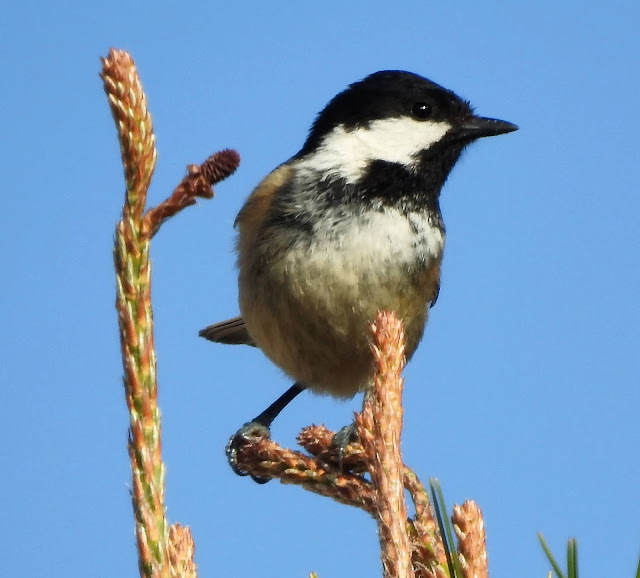The Coal tit (Periparus ater) is a small passerine bird widespread and common resident breeder throughout the temperate to subtropical Palearctic, including North Africa.
The Coal tit has a distinctive large white nape spot on its black head. The head, throat, and neck of the adult are glossy blue-black, setting off the off-white sides of the face (tinged grey to yellow depending on subspecies) and the brilliant white nape; the white tips of the wing coverts appear as two wingbars. The underparts are whitish shading through buff to rufous on the flanks. The bill is black, the legs lead-colored, and the irides dark brown. The young birds are duller than the adults, lacking gloss on the black head, and with the white of nape and cheeks tinged with yellow.
Coal tits are found throughout Europe, Asia, and North Africa. They are all-year residents throughout almost all range, making only local movements in response to particularly severe weather; only the Siberian birds have a more regular migration. Coal tits prefer humid conifer forests but also frequent shrubland, conifer plantations, gardens, and urban areas.
Coal tits are social birds and often form small flocks in winter with other tits. They resemble other tits in acrobatic skill and restless activity, though they more frequently pitch on a trunk, and in little hops resemble a treecreeper. Coal tits are active during the day spending most of their time searching for food trees. They also visit gardens to feed on a variety of foods put out, particularly sunflower seeds. While searching for food, Coal tit flocks keep contact with incessant short 'dee' or 'see-see' calls. Their song is a strident 'if-he, if-he, if-he', heard most frequently from January to June, but also in autumn. The song resembles that of the Great tit, but much faster and higher in pitch. North African birds also have a 'currr' call similar to that of the European crested tit which is not found in Africa.
Coal tits breed once per year between March and late July. They prefer to nest in a hole in a rotting tree stump, often low down, and the nest is deep within the hole; holes in the ground, burrows of mice or rabbits, chinks between the stones in walls, old nests of Pica magpies or other large birds, and squirrel dreys are also occupied. The materials, moss, hair, and grass, are closely felted together, and rabbit fur or feathers are added for the lining. The female lays 7 to 11 red-spotted white eggs and incubates them for 14-16 days. The chicks hatch blind and helpless and remain in the nest for about 14 to 19 days.
%2020.jpg)
%2021.jpg)
%2022.jpg)






































%2020.jpg)

%2021.jpg)
%2011.jpg)
%2010.jpg)
%2012.jpg)
%2014.jpg)
%2021.jpg)
%2022.jpg)